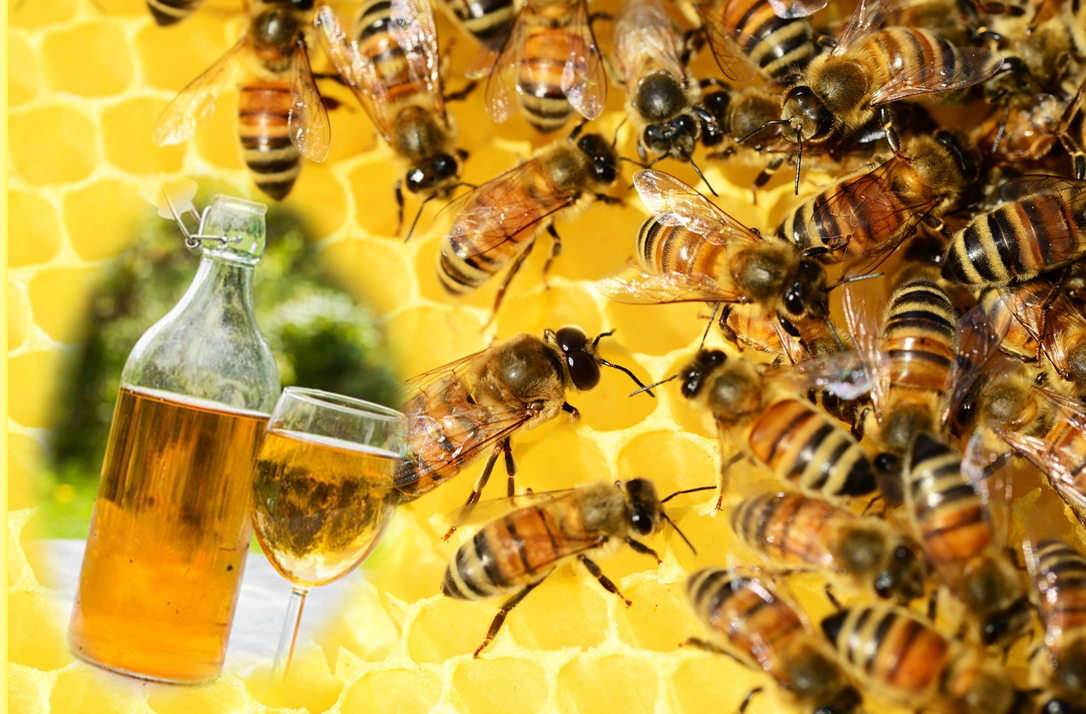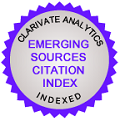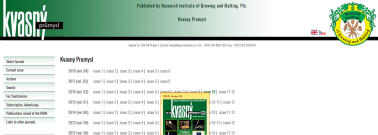Honey Mead Fermentation from Thai Stingless Bee (Tetragonula leaviceps) Honey using Ethanol Tolerant Yeast
DOI:
https://doi.org/10.18832/kp2021.67.503Keywords:
stingless bee, honey wine, ethanol, fermented food, beverageAbstract
Honey mead is a well-known conventional alcoholic beverage made by microbial fermentation of diluted honey. The selection of prospective yeasts for inoculation of honey-must with regard to honey mead quality determines the quality of mead production. The yeast consortium tolerant to ethanol stress was selected for this study using an enrichment technique. The activity of the invertase enzyme and the level of ethanol tolerance have been investigated. Thai stingless bee honey was used as a substrate, and the selected ethanol tolerant yeast consortium was used for mead fermentation. The results revealed that the PP03 had the highest invertase activity of 75.13±9.16 U/mL and the highest ethanol tolerance level of 12%. This is the first study using an ethanol tolerant yeast consortium to ferment honey mead from Thai stingless bee honey.
References
Anderson, M.J., Barker, S.L., Boone, C., Measday, V. (2012). Identification of RCN1 and RSA3 as ethanol-tolerant Saccharomyces cerevisiae using a high copy barcoded library. FEMS Yeast Research, 12(1), 48–60. https://doi.org/10.1111/j.1567-1364.2011.00762.x
Ali, S., Aslam, A., Hayyat, M.U. (2016). Double mutation of Saccharomyces cerevisiae for enhanced β-d-fructofuranosidase fructohydrolase productivity and application of growth kinetics for parametric significance analysis. Industrial Microbiology, 47, 136–142. https://doi.org/10.1016/j.bjm.2015.11.024
Balogu, T.V., Towobola, O. (2017). Production and quality analysis of wine from honey and coconut milk blend using Saccharomyces cerevisiae. Fermentation, 3(16), 1–9. https://doi.org/10.3390/fermentation3020016.
Casey, G.P., Ingledew, W.M.M. (1986). Ethanol tolerance in yeasts. CRC Critical Review in Microbiology, 13(3), 219–280. https://doi.org/10.3109/10408418609108739
Chang, K.J., Thach, M.W.L., Olsen, J. (2016). Wine and health perceptions: exploring the impact of gender, age and ethnicity on consumer perceptions of wine and health. Wine Economics and Policy, 5(2), 105–113. https://doi.org/10.1016/j.wep.2016.09.001
Chi, Z., Arneborg, N. (2000). Saccharomyces cerevisiae strains with different degrees of ethanol tolerance exhibit different adaptive responses to produced ethanol. Journal of Industrial Microbiology & Biotechnology, 24, 75–78.
Cooray, S.T., Lee, J.J.L., Chen, W.N. (2017). evaluation of brewers’ spent grain as a novel media for yeast growth. AMB Express, 7, 117. https://doi.org/10.1186/s13568-017-0414-1
De Groot, A.P. (1953). Protein and amino acid requirement of the honeybee Apis mellifera. Physiologia Comparata et d’ Ecogia, 3, 195–285.
De Simon, B.F., Martinez, J., Sanz, M., Cadahia, E., Esteruelas, E., Esteruelas, E., Munoz, A.M. (2014). Volatile compounds and sensorial characterization of red wine aged in cherry, chestnut, false acacia, ash and oak wood barrels. Food Chemistry, 147, 346–356. https://doi.org/10.1016/j.foodchem.2013.09.158
Edelhauser, M., Bergner, K.G. (1987). Proteine Des Bienenhonigs. Lebensmittelunters. Forsch.
Flor, P.Q., Hayashida, S. (1983). Saccharomyces uvarum inulyticus var. nov., a new high-concentration ethanol tolerant yeast from rice wine. European Journal of Applied Microbiology and Biotechnology, 18, 148–152. https://doi.org./10.1007/BF00498036
Ganucci, D., Guerrini, S., Mangani, S., Vincenzini, M., Granchi, L. (2018). Quantifying the effects of ethanol and temperature in the fitness advantage of predominat Saccharomyces cerevisiae strains occurring in spontaneous wine fermentations. Frontiers in Microbiology, 9, 1563.https://doi.org./10.3389/fmicb.2018.01563.
Ghasemi, Y., Mohkam, M., Ghasemi, A., Rasoul-Amini, S. (2014). Experimental design of medium optimization for invertase production by Pichia sp. Journal of Food Science and Technology, 51, 267–275. https://doi.org./ 10.1007/s13197-011-0494-x
Guan, D., Li, Y., Shiroma, R., Ike, M., Tokuyasu, K. (2013). Sequential incubation of Candida shehatae and ethanol-tolerant yeast cells for efficient ethanol production from a mixture of glucose, xylose and cellobiose. Bioresource Technology, 132, 419–422. https://doi.org/10.1016/j.biortech.2012.12.040
Gupta, J.K., Sharma, R. (2009). Production technology and quality characteristics of mead and fruit-honey wines: a review. NPR, 8(4), 345–355.
Haq, I.U., Baig, M.A., Ali, S. (2005). Effect of cultivation condition on invertase production by hyperproducing Saccharomyces cerevisiae isolates. World Journal of Microbiology Biotechnology, 21, 487-492. https:/doi.org/10.1007/s11274-004-2612-7.
Hornsey, I.S. (2007). A history of beer and brewing. Royal Society of Chemistry, Cambridge, pp. 760. ISBN 0854046305
Jame, C.N. (2004). Recruitment communication in stingless bees (Hymenoptera, Apidae, Meliponini). Apidologie, 35, 159–182. https://doi.org/10.1051/apido:2004007
Jimnez, J., Benitez, T. (1986). Characterization of wine yeasts for ethanol production. Applied Microbiology and Biotechnology, 25, 150–154. https://doi.org/10.1007/BF01982839
Kulshrestha, S., Tyagi, P., Sindhi, V., Yadavilli, S. (2013). Invertase and its applications – A brief review. Journal of Pharmacy Research, 7(9), 792–797. https://doi.org/10.1016/j.jopr.2013.07.014
Kumar, R., Kesavapillai, B. (2012). Stimulation of extracellular production from spent yeast when sugarcane pressmud used as substrate through solid state fermentation. SpringerPlus, 1(1), 81. https://doi.org/10.1186/2193-1801-1-81
Lim, D.C.C., Bakar, M.F.A., Majid, M. (2019). Nutritional composition of stingless bee honey from different botanical origins. Earth and Environmental Science, 269, 012025. https://doi.org/10.1088/1755-1315/269/1/012025
Makwana, M., Hati, S. (2019). Fermented Beverages. Woodhead Publishing, Cambridge. ISBN: 9780128152713
Mendes-Ferreira, A., Cosme, F., Barbosa, C., Falco, V., Ines, A., Mendes-Faia, A. (2010). Optimization of honey-must preparation and alcoholic fermentation by Saccharomyces cerevisiae for mead production. International Journal of Food Microbiology, 144, 193–198. https://doi.org/10.1016/j.ijfoodmicro.2010.09.016
Moneke, A.N., Okolo, B.N., Nweke, A.I., Ezeogu, L.I., Ire, F.S. (2008). Selection and characterisation of high ethanol tolerant Saccharomyces yeasts from orchard soil. African Journal of Biotechnology, 7(24), 4567–4575.
Nguyen, H.P., Le, H.D., Le, V.V.M. (2015). Effect of ethanol stress on fermentation performance of Saccharomyces cerevisiae cells immobilized on nypa fruticans leaf sheath pieces. Food Technology & Biotechnology, 53(1), 96–101. https://doi.org/10.17113/ftb.53.01.15.3617
Osho, A. (2005). Ethanol and sugar tolerance of wine yeasts is fermenting cashew apple juice. African Journal of Biotechnology, 4(7), 660-662.
Park, A.H., Sugiyama, M., Harashima, S., Kim, Y.H. (2012). Creation of an ethanol-tolerant yeast strain by genome reconstruction based chromosome splitting technology. Journal of Microbiology and biotechnology, 22(2), 184–189. http://dx.doi.org/10.4014/jmb.1109.09046
Pereira, A.P., Mendes-Ferreira, A., Oliveira, J.M., Estevinho, L.M., Mendes-Faia, A. (2013). High-cell-density fermentation of Saccharomyces cerevisiae for the optimization of mead production. Food Microbiology, 33, 114–123. https://doi.org/10.1016/j.fm.2012.09.006
Perreira, A.P., Mendes-Ferreira, A., Dias, L.G., Oliveira, J.M., Estevinho, L.M., Mendes-Faia, A. (2019). Volatile composition and sensory properties of mead. Microorganisms. 7, 1-16. https://doi.org/10.3390/microorganisms7100404.
Pina, C., Santos, C., Couto, J.A., Hogg, T. (2004). Ethanol tolerance of five non-Saccharomyces wine yeasts in comparison with s strain of Saccharomyces cerevisiae – influence of different culture conditions. Food Microbiology, 21, 439-447.
Priya, V.P.A., Anutha, S., Mangalam, H. (2011). Isolation, characterization of ethanol tolerant yeast. Journal of Pure and Applied Microbiology. 5(1), 313–316.
Sawatthum, A., Vaithanomsat, P., Tadakittisarn, S. (2009). Comparitive composition of honey from thai stingless bee and european honey bee. KUCONF, 52, 4271020.
Se, K.W., Ibrahim, R.K.R., Wahab, R.A., Ghoshal, S.K. (2018). Accurate evaluation of sugar contents in stingless bee (Heterotrigona itama) honey using a swift scheme. Journal of Food Composition and Analysis, 66, 46–54. https://doi.org/10.1016/j.jfca.2017.12.002
Shatif, K., Ali, S., Haq, I.U. (2002). Effect of different mineral nutrients on invertase production by sachcaromyces cerevisiae GCB-K5. Biotechnology 1(1), 40–44. https://doi.org/10.3923/biotech.2002.40.44
Shiby, V.K., Misha, H.N. (2013). Fermented milks and milk products as functional foods – a review. Critical Reviews in Food Science and Nutrition, 53(5), 482–496. https://doi.org/10.1080/10408398.2010.547398
Stanley, D., Fraser, S., Chambers, P.J., Rogers, P., Stanley, G.A. (2010). Generation and characterization of stable ethanol-tolerant mutants of Saccharomyces cerevisiae. Journal of Industrial Microbiology and Biotechnology, 37(2), 139–149. https://doi.org/10.1007/s10295-009-0655-3
Sumby, K.M., Betteridge, A.L., Jiranek, V. (2019). Ethanol-tolerant lactic acid bacteria strains as a basis for efficient malolactic fermentation in wine: evaluation of experimentally evolved lactic acid bacteria and winery isolates. Australian Journal of Grape and Wine Research, 25(4), 404–413. https://doi.org/10.1111/ajgw.12410
Suntiparapop, K., Prapaipong, P., Chantawannakul, P. (2011). Chemical And Biological Properties Of Honey From Thai Stingless Bee (Tetragonula leaviceps). Journal of Apicultural Research, 51(1), 45-52. https://doi.org/10.3896/IBRA.1.51.1.06
Tikka, C., Osuru, H.P., Atluri, N., Raghavulu, P.C.V., Yellapu, N.K., Mannur, I.S., Prasad, U.V., Aluru, S., Varma, N.K., Bhaskar, M. (2013). Isolation and characterization of ethanol tolerant yeast strains. Bioinformation, 9(8), 421–425. https://doi.org/10.6026/97320630009421
Thmmasittirong, S.N.R., Chamduang, Y., Phonrod, U., Sriroth, K. (2012). Ethanol production potential of ethanol-tolerant Saccharomyces And Non-Saccharomyces Yeast. Polish Journal of Microbiology, 61(3), 219–221. https://doi.org/10.33073/pjm-2012-029
Thmmasittirong, S.N.R., Thirasaktana, T., Thammasittirong, A., Srisodsuk, M. (2013). Improvement of ethanol production by ethanol tolerant Saccharomyces cerevisiae UVNR56. SpringerPlus, 2, 1-5. https://doi.org/10.1186/2193-1801-2-583
Tyokusa, A.G., Owuama, C.I. (2018). Indigenous ethanol tolerant Saccharomyces cerevisiae isolates for Mangifera indica and Ananas comosus wines production. International Journal of Science, Environment and Technology, 7(2), 435–450.
Villarreal, P., Quintrel, P.A., Olivares-Munoz, S., Ruiz, J.J., Nespolo, R.F., Cubillos, F.A. (2021). Identification of new ethanol-tolerant yeast strains with fermentation potential from central Patagonia. Yeast, https://doi.org/10.1002/yea.3662
Vitolo, M., Duranti, M.A., Pellegrim, M.B. (1995). Effect of pH, aeration and sucrose feeding on the invertase activity of intact S. cerevisiae cells grown in sugarcane blackstrap molasses. Journal of Industrial Microbiology, 15(2), 75-79. https://doi.org/10.1007/BF01569803
Walker, G., Stewart, G. (2016). Saccharomyces cerevisiae in the production of fermented beverages. Beverages, 2(4), 30. https://doi.org/10.3390/beverages2040030
Yamaoka, C., Kurita, O., Kubo, T. (2014). Improved ethanol tolerance of Saccharomyces cerevisiae in mixed culture with Kluyveromyces lactis on high-sugar fermentation. Microbiological research, 169, 907-914. http://dx.doi.org/10.1016/j.micres.2014.04.007

Downloads
Published
How to Cite
Issue
Section
License
Copyright (c) 2021 Pimprapa Chaijak, Purimprach Sinkan, Santipap Sotha

This work is licensed under a Creative Commons Attribution 4.0 International License.







